Everything You Need to Know About Ruby Engagement Rings

Derived from the Latin word for “red,” “ruben,” ruby engagement rings have become a popular choice for couples looking to purchase a unique engagement ring. For rubies, the most important aspect to consider value-wise is the quality of the center stone; the more richly red and clearer the ruby, the more value it holds. Typically, a ruby is paired with yellow or rose gold, but other metals have proven to look good throughout the years.
TABLE OF CONTENTS
Ruby Engagement Ring Origin
Found in Burma, Afghanistan, Australia, India, Madagascar, and several other places including parts of the United States, the ruby is rare and held in high regard. Unique ruby engagement rings such as Fergie's large ruby diamond engagement ring piqued the interest of modern brides everywhere. Although rubies are typically blood red, the diamond and blue ruby engagement rings have also garnered a lot of attention in modern-day.
Ruby History
Although diamonds previously ruled the engagement ring world, the diamond paired with the ruby in the seventeenth and eighteenth centuries in order to symbolize eternity and love. Among the wealthy, this contrast between the stones became a hot commodity. Hindus also thought highly of the ruby by separating the ruby into castes; they were sorted into upper, middle, and lower class in terms of beauty, quality, and color. It was thought that a lower ruby could not even touch an upper ruby in fear that it would contaminate it.
Ruby Meaning
Nowadays, the engagement rings with rubies are said to represent desire through their rich red color. Desire may be an important aspect of ruby, but rubies also symbolize love and courage. Legend has it that the ruby is not a stone at all, but it is hardened fire with the power to set hearts aflame. Also known as the “Stone of Nobility,” the ruby is said to amplify and bring light and peace into one's life. Peace-wise, it is said that the ruby can settle fights between lovers.
Choosing a Ruby and Diamond Ring
Ruby solitaire, three stone, and ruby accent gemstone rings are rich, beautiful options for engagement rings. However, some people feel that adding a diamond to the mix, or making the accent stones diamonds rather than tiny rubies gives those rings an unmatched appeal.
Take the round brilliant cut white gold ruby solitaire engagement ring. The deep red ruby will catch the eye of admirers everywhere all by itself. However, dress up the band with accent diamonds, or alternate small diamonds with rubies all along the band, and eye catching becomes eye popping.
A tri-stone ruby engagement ring on a yellow gold band will certainly stand out in a crowd. Replace the two smaller stones on either side of the center ruby with diamonds, which will bring out the shine of the gold band, as well as the intensity of the red gemstone, for a breathtaking engagement ring of which anyone would be envious.
Buying a Ruby Ring vs a Diamond Ring
Replacing some of the rubies in an all-ruby ring with diamonds can actually save you a little bit of money, as well as alter the look and style of the ring. By carat, diamonds are less costly than rubies that are the same size. True, natural, excellent-grade rubies are considered rarer than diamonds and are therefore considerably higher in value. So, playing around with the various combinations of rubies and diamonds while shopping for a ruby engagement ring can help you create a gorgeous ring that's easier on your pocketbook.

Popular Shapes for Ruby Engagement Rings
The most popular gemstone cut for ruby engagement rings is the round cut. This circular shape brings out all the important qualities of the ruby gemstone, accentuating its critical features while offering some of the best prices in the ruby market.
Round Cut Rubies match well with other round cut stones, and they leave room for all types of creative metalwork in solitaire rings, such as vines, filigree, floral and nature-inspired metal designs.
Oval Shaped Rubies are another common stone cut for rings. Ovals can be paired with smaller ovals, round cut gems, and any accent gemstones. Oval cut stones often appear larger, and offer elegance and a delicate look on a bride-to-be's finger.
Cushion Cut Rubies make amazing, vintage-looking ruby engagement rings. Paired with ruby or diamond halos and filigree metalwork, these gemstones create antique style rings that even modern brides will love.
Square Shaped Rubies match with any of the sharp-edged and cornered shapes, such as princess cut, rectangle cut, emerald cut, etc. They also pair well with cushion cut gemstones and are among the top ten popular ruby cuts for engagement rings.
Common Setting Styles for Ruby Engagement Rings
Pave settings are a common choice for ruby engagement rings. It's simple, classic, elegant, and it works for solitaires, tri-stones, accent gemstones, and any other styles. They can also be set in yellow, rose and white gold, as well as platinum, silver, and any of the other white metals used for ruby engagement rings.
Four-prong settings are often used in ruby rings. The ruby rests securely inside the prongs, and any band design or metalwork accents complement the stone shapes and cuts.
The bezel is another common setting for ruby engagement rings. Bezel allows for alternating gemstone shapes, and for a center stone that appears larger than its actual size. It also sits well in many of the preferred ruby engagement ring metals available on the market.
Types of Natural Rubies
| Name | Color | Origin |
|---|---|---|
| Burmese Ruby Stones | Deep Red Color | Myanmar |
| African Ruby Stone | Purplish to Dark Red Color | Mozambique and Kenya |
| Thai Ruby Gesmtone | Dark in Color | Bangkok |
| Tanzania Ruby Gemstone | Intensity of Color Diminished with Size | Songea |
| Madagascar Ruby Stone | Red, Orange, and Natural Red | Andilamena and Vatomandry |
| Afghanistan Ruby Gemstone | Ranges from Light to Dark Red | Badakshan and Jagdalek |
Ruby Engagement Ring Metal Options
As with other gemstone engagement rings, ruby rings have certain metals that best suit the deep hues of the red stones.
Yellow gold is typically the most commonly favored metal for ruby engagement rings that are paired with diamonds. Pure yellow gold accentuates the brilliance of the diamonds, as well as the rich, blood-red color of the ring's rubies. The gold ties together all the qualities of the gemstones with the ring's specific setting, creating a heart-stopping ruby-and-diamond engagement ring brides will love.
Yellow gold is considerably costlier than the white metals because most white metals are blended with a percentage of silver, which is cheaper price-wise than pure gold.
Rose gold is common and popular for all-ruby engagement rings. The pinkish tint to rose, gold bands, are the perfect complement to the red brilliance of the rubies. Although rose gold is most commonly used in rings with rubies only, it also looks great with large ruby center stones nestled between smaller diamonds.
Rose gold is a less expensive gold metal because it's softer than yellow gold. It's also mixed with different minerals and components, which is how its pink color is created. This decreases the ratio of “pure” gold in the metal, which lowers the hefty price tags that pure yellow gold often carries.
White gold and platinum are two of the white metals often used to make ruby engagement rings. The white metals are typically used in rings with a higher diamond-to-ruby ratio, or for rings in which the diamonds are bigger than the rubies.
Platinum is a more highly-valued metal than white gold because platinum is more naturally white than white gold. White gold, as we mentioned, is mixed with silver, whereas platinum is white by nature.
Our Top Ruby Rings
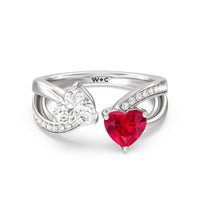
Toi et Moi Created Ruby & Lab Diamond Heart Engagement Ring
Perfect for the romantic at heart, this engagement ring features a created ruby and a heart-shaped lab diamond. The stones are set on a graceful band, symbolizing the unity and love shared between two people.
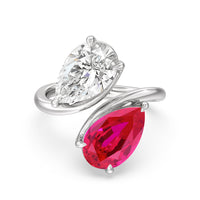
Toi et Moi Created Ruby and Lab Diamond Bypass Engagement Ring
A modern twist on the classic bypass design, this ring features a created ruby and a lab diamond that seemingly dance around each other. The bypass setting elegantly cradles both stones, highlighting their unique brilliance and significance.
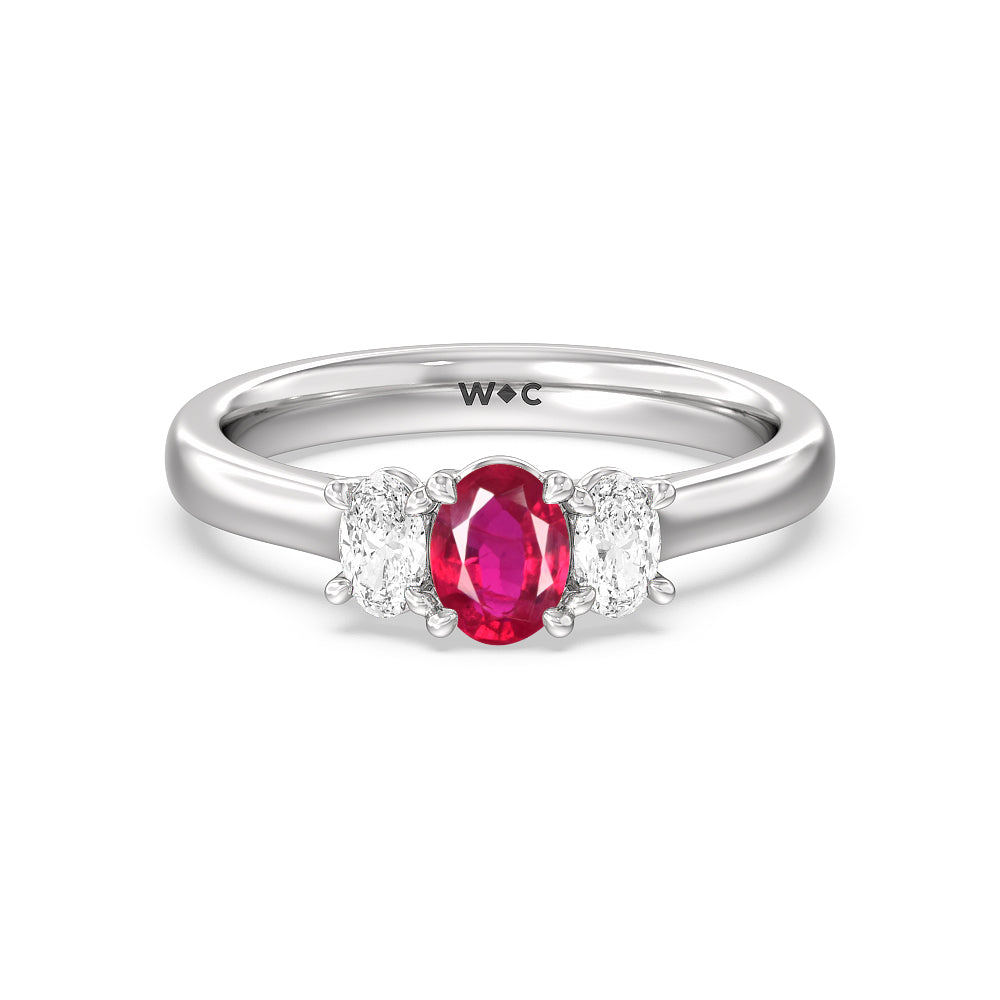
Created Ruby Center And Oval Cut Three Stone Diamond Ring
This elegant three stone ring features a vibrant created ruby flanked by two oval cut lab diamonds. The smooth, elongated shapes of the side diamonds perfectly complement the bold center stone, making it a sophisticated choice for any occasion.
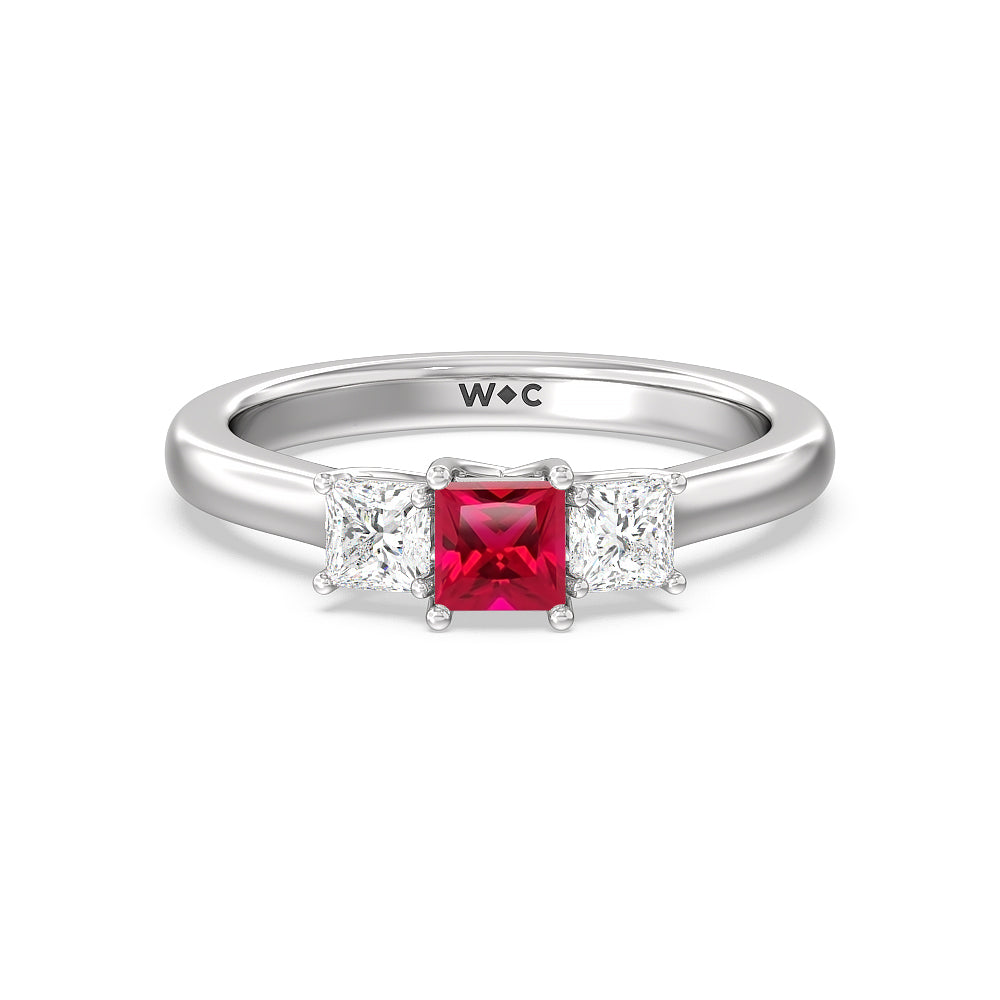
Created Ruby Center And Princess Cut Three Stone Diamond Ring
This ring showcases a captivating created ruby flanked by two princess cut lab diamonds. The vibrant center stone is elegantly highlighted by the shimmering side diamonds, making this three stone ring a timeless choice for expressing your love.
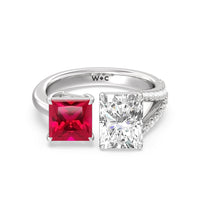
Toi et Moi Created Ruby Princess and Radiant Lab Diamond Split Shank Engagement Ring
Celebrate duality with this stunning Toi et Moi ring. Featuring a created ruby and a radiant lab diamond, each set on a split shank band. The contrasting shapes and colors of the stones symbolize the beautiful union of two souls.
FAQs
Are rubies good for engagement rings?
Rubies are one of the most vivid and durable gemstones. While not as hard as diamonds, they are harder than other precious gemstones like emeralds. Therefore, rubies make for a good choice when it comes to engagement rings or anniversary rings.
How to clean a ruby ring?
Ruby rings can be cleaned with a fine jewelry cleaner at home or with a small amount of non-abrasive dish soap and warm water. The best way to clean ruby jewelry is to work with a jeweler who can use ultrasonic and steam cleaning to ensure all the grease, grime and buildup from the ring is quickly removed.
Which finger is a ruby ring worn on?
For those looking to purchase an engagement ring, ruby rings are worn on the ring finger on the left hand. For those looking for a statement, anniversary or right hand ring, ruby rings are typically worn on the middle or ring finger of the right hand.
How to tell if my ruby is real?
Rubies are often sold in varying qualities to customers. The best way to access if a ruby ring is real is having it appraised by an accredited lab. This is the best way to assess not only the quality, but any treatments to enhance clarity and color that the ruby ay have undergone.









